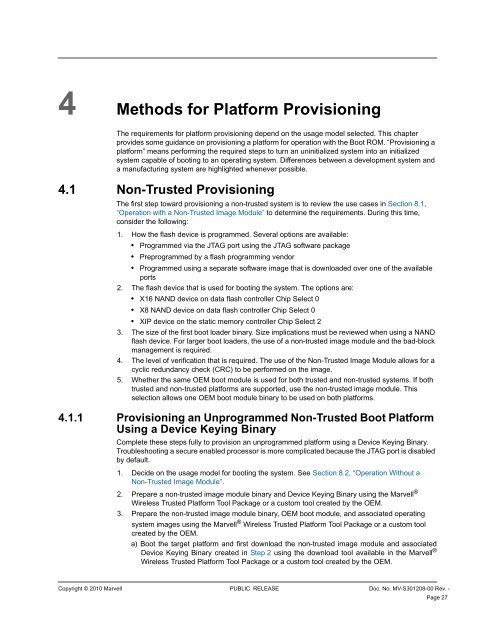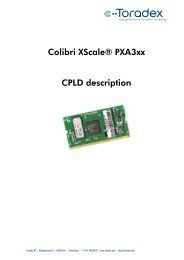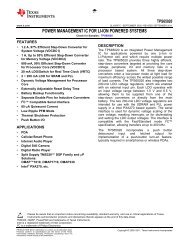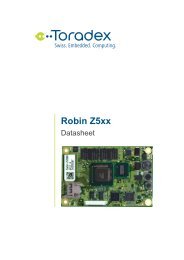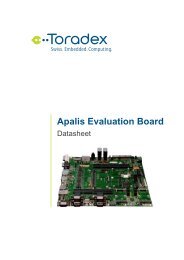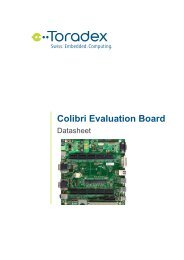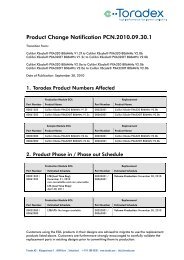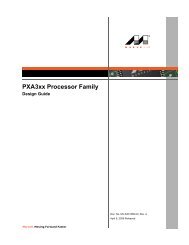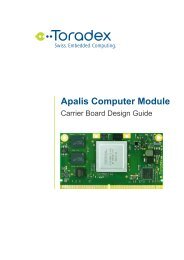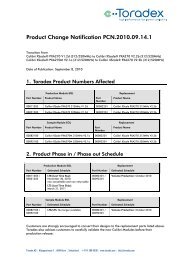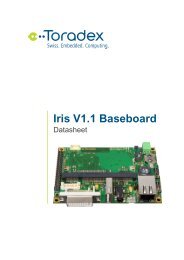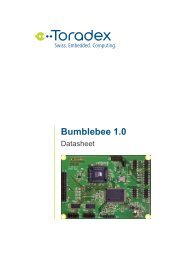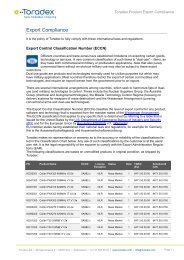PXA3xx Boot ROM Reference Manual - Marvell
PXA3xx Boot ROM Reference Manual - Marvell
PXA3xx Boot ROM Reference Manual - Marvell
- No tags were found...
You also want an ePaper? Increase the reach of your titles
YUMPU automatically turns print PDFs into web optimized ePapers that Google loves.
4 Methods for Platform ProvisioningThe requirements for platform provisioning depend on the usage model selected. This chapterprovides some guidance on provisioning a platform for operation with the <strong>Boot</strong> <strong>ROM</strong>. “Provisioning aplatform” means performing the required steps to turn an uninitialized system into an initializedsystem capable of booting to an operating system. Differences between a development system anda manufacturing system are highlighted whenever possible.4.1 Non-Trusted ProvisioningThe first step toward provisioning a non-trusted system is to review the use cases in Section 8.1,“Operation with a Non-Trusted Image Module” to determine the requirements. During this time,consider the following:1. How the flash device is programmed. Several options are available:• Programmed via the JTAG port using the JTAG software package• Preprogrammed by a flash programming vendor• Programmed using a separate software image that is downloaded over one of the availableports2. The flash device that is used for booting the system. The options are:• X16 NAND device on data flash controller Chip Select 0• X8 NAND device on data flash controller Chip Select 0• XIP device on the static memory controller Chip Select 23. The size of the first boot loader binary. Size implications must be reviewed when using a NANDflash device. For larger boot loaders, the use of a non-trusted image module and the bad-blockmanagement is required.4. The level of verification that is required. The use of the Non-Trusted Image Module allows for acyclic redundancy check (CRC) to be performed on the image.5. Whether the same OEM boot module is used for both trusted and non-trusted systems. If bothtrusted and non-trusted platforms are supported, use the non-trusted image module. Thisselection allows one OEM boot module binary to be used on both platforms.4.1.1 Provisioning an Unprogrammed Non-Trusted <strong>Boot</strong> PlatformUsing a Device Keying BinaryComplete these steps fully to provision an unprogrammed platform using a Device Keying Binary.Troubleshooting a secure enabled processor is more complicated because the JTAG port is disabledby default.1. Decide on the usage model for booting the system. See Section 8.2, “Operation Without aNon-Trusted Image Module”.2. Prepare a non-trusted image module binary and Device Keying Binary using the <strong>Marvell</strong> ®Wireless Trusted Platform Tool Package or a custom tool created by the OEM.3. Prepare the non-trusted image module binary, OEM boot module, and associated operatingsystem images using the <strong>Marvell</strong> ® Wireless Trusted Platform Tool Package or a custom toolcreated by the OEM.a) <strong>Boot</strong> the target platform and first download the non-trusted image module and associatedDevice Keying Binary created in Step 2 using the download tool available in the <strong>Marvell</strong> ®Wireless Trusted Platform Tool Package or a custom tool created by the OEM.12345678910111213141516171819202122232425262728293031323334353637383940414243444546474849505152535455565758Copyright © 2010 <strong>Marvell</strong> PUBLIC RELEASE Doc. No. MV-S301208-00 Rev. -Page 27


